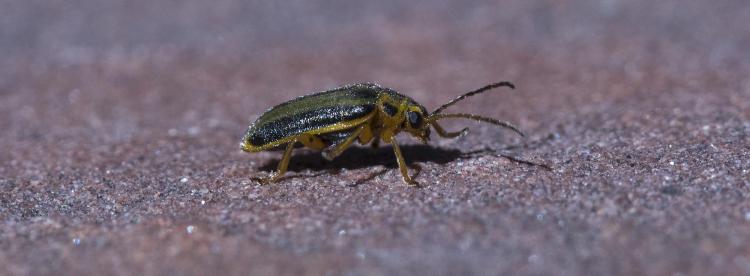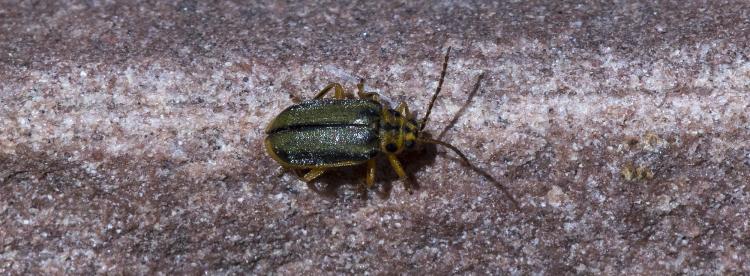Elm leaf beetles are just one of the introduced species that suppress American elms
Introductions, both accidental and purposeful, frequently have tragic consequences
American elms, Ulmus americana, are native to North America from Saskatchewan to Nova Scotia and from Texas to Florida. They grow 60 to 80 feet tall, with a thick trunk, the shape of a vase and a domed crown 40 to 50 feet wide. In fall, the leaves on a single tree can take on a range of colors, including yellow, russet, orange and bronze. Years ago, their life expectancy was about 400 years. These attractive, healthy and long-lived trees were embraced by horticulturists and city planners, who chose elms to grace the main streets and boulevards, their crowns forming a shady canopy over roads. Although their natural range had a boundary at the western edge of the Great Plains, they were introduced to growing towns such as Denver and Boulder, so their modern range was extended to the Pacific Ocean.
If we could interview an old elm, it would tell us that that long ago, elms were content and thriving in their native range and that more recently they enjoyed the attention of widespread planting by people who appreciated elm's size, form, colors and shade. But recently, elms have suffered calamitous consequences from inadvertent introductions of herbivores and diseases.

Elm leaf beetles are introduced, and they feed on American elms but are managed by introduced egg parasites. Photo by Jeff Mitton.
The elm leaf beetle, Xanthogaleruca luteola (or Pyrrhalta luteola) is a native of southern Europe, but it found its way to North America in the late 1800s. Adults are small, 6 or 8 mm (0.25 inches) long, and their elytra or wing covers are dark green when adults are overwintering in crevices of elm bark, or in loose duff on the forest floor, or in your house if they can find a way in. Adults turn to yellow with black markings as they become active in spring. Both larvae and adults feed on elm leaves. Larvae eat from the underside of the leaf but do not usually penetrate the uppermost layer, nor do they eat the leaf veins, so their feeding skeletonizes the leaves. Adults eat from the upper surface, punching small round holes though the leaves. Leaves damaged by feeding usually turn brown, so that heavily grazed branches look as though they have been burned. If beetles are numerous, they defoliate trees, which rarely kills but surely weakens them.
In an effort to control populations of elm leaf beetles, managers introduced a wasp, Oomyzus gallerucae, which lays its eggs on egg masses of the elm leaf beetle. Wasps were introduced to California and Ohio from 1908 to 1936, and then again for two decades starting in 1970. In 1989, an entomologist at the University of Missouri found the wasps on campus, throughout much of Missouri and in the neighboring states. The wasp had become self-sustaining and it had spread far from its sites of introduction. The wasps have reduced populations sizes of elm leaf beetles to the point that their herbivory is no longer a major problem.
In 1910 the elm bark beetle, Scolytus multistriatus, was accidentally introduced to North America. It tunnels through the bark around the bases of branches, killing some branches, but it was not considered much of a problem.

Elm leaf beetles are introduced, and they feed on American elms but are managed by introduced egg parasites. Photo by Jeff Mitton.
In 1919, reports spread of elms dying in Holland, and in 1921, the agent causing Dutch elm disease was identified as a fungus, Ceratocystis ulmi. In 1930, this fungus was accidentally introduced to Ohio, where bark beetles attacking elms began to vector the fungus, greatly enhancing the spread of Dutch elm disease. Once the beetle inoculates a twig with the fungus, the fungus usually kills the tree in a few years.
Elm disease was devastating, for it decimated stands of a dominant tree in eastern deciduous forests and also took one of America's favorite shade trees. In Denver, which originally had only cottonwoods along rivers and creeks, approximately 100,000 American elms were planted, making them the favored and most numerous of shade trees in Denver. Dutch elm disease first appeared in Colorado in 1948, but it may have died out. However, it appeared again in 1968, and after it had swept through the city, only 2% of the American elms remained. Similarly, elms became either locally extinct or rare in their native range.
Introductions in the last two centuries have transformed our forests. Chestnut blight followed by elm disease removed the largest forest trees from eastern deciduous forests and altered the look of suburbia across the nation. In western coniferous forests, white pine blister rust is decimating stands of sugar pine and whitebark pine and also invading stands foxtail pine, limber pine and bristlecone pine. The list of introductions gone wrong is long--examples that come immediately to mind include tamarisk, amphibian chytrid fungus, brown trout and cheatgrass. Introductions, both accidental and purposeful, frequently have tragic consequences.

